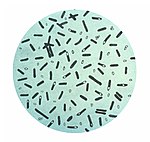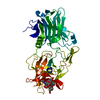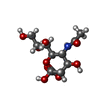| Entry | Database: PDB / ID: 8rvh
|
|---|
| Title | Structure of the binding domain of BoNT/A mutant Y1117V/H1253K in complex with the GD1a ganglioside receptor |
|---|
 Components Components | Botulinum neurotoxin A heavy chain |
|---|
 Keywords Keywords | TOXIN / botulinum neurotoxin / receptor binding / ganglioside |
|---|
| Function / homology |  Function and homology information Function and homology information
symbiont-mediated suppression of host exocytosis / ganglioside GT1b binding / Toxicity of botulinum toxin type A (botA) / bontoxilysin / host cell presynaptic membrane / host cell cytoplasmic vesicle / host cell cytosol / protein transmembrane transporter activity / metalloendopeptidase activity / toxin activity ...symbiont-mediated suppression of host exocytosis / ganglioside GT1b binding / Toxicity of botulinum toxin type A (botA) / bontoxilysin / host cell presynaptic membrane / host cell cytoplasmic vesicle / host cell cytosol / protein transmembrane transporter activity / metalloendopeptidase activity / toxin activity / host cell plasma membrane / proteolysis / extracellular region / zinc ion binding / membraneSimilarity search - Function Clostridium neurotoxin, translocation / Clostridium neurotoxin, Translocation domain / Clostridium neurotoxin, translocation domain / Clostridium neurotoxin, receptor-binding C-terminal / Clostridium neurotoxin, C-terminal receptor binding / Clostridial neurotoxin zinc protease / Botulinum/Tetanus toxin, catalytic chain / Clostridium neurotoxin, receptor binding N-terminal / Clostridium neurotoxin, N-terminal receptor binding / Kunitz inhibitor STI-like superfamily ...Clostridium neurotoxin, translocation / Clostridium neurotoxin, Translocation domain / Clostridium neurotoxin, translocation domain / Clostridium neurotoxin, receptor-binding C-terminal / Clostridium neurotoxin, C-terminal receptor binding / Clostridial neurotoxin zinc protease / Botulinum/Tetanus toxin, catalytic chain / Clostridium neurotoxin, receptor binding N-terminal / Clostridium neurotoxin, N-terminal receptor binding / Kunitz inhibitor STI-like superfamily / Neutral zinc metallopeptidases, zinc-binding region signature. / Concanavalin A-like lectin/glucanase domain superfamilySimilarity search - Domain/homology |
|---|
| Biological species |   Clostridium botulinum (bacteria) Clostridium botulinum (bacteria) |
|---|
| Method |  X-RAY DIFFRACTION / X-RAY DIFFRACTION /  SYNCHROTRON / SYNCHROTRON /  MOLECULAR REPLACEMENT / Resolution: 1.8 Å MOLECULAR REPLACEMENT / Resolution: 1.8 Å |
|---|
 Authors Authors | Masuyer, G. / Stenmark, P. |
|---|
| Funding support |  Sweden, 1items Sweden, 1items | Organization | Grant number | Country |
|---|
| Swedish Research Council | |  Sweden Sweden |
|
|---|
 Citation Citation |  Journal: Commun Chem / Year: 2025 Journal: Commun Chem / Year: 2025
Title: Botulinum neurotoxin A mutants with enhanced ganglioside binding show improved potency and altered ganglioside selectivity.
Authors: Masuyer, G. / Rummel, A. / Stenmark, P. |
|---|
| History | | Deposition | Feb 1, 2024 | Deposition site: PDBE / Processing site: PDBE |
|---|
| Revision 1.0 | Feb 12, 2025 | Provider: repository / Type: Initial release |
|---|
| Revision 1.1 | Aug 27, 2025 | Group: Database references / Category: citation
Item: _citation.country / _citation.journal_abbrev ..._citation.country / _citation.journal_abbrev / _citation.journal_id_CSD / _citation.journal_id_ISSN / _citation.journal_volume / _citation.page_first / _citation.page_last / _citation.pdbx_database_id_DOI / _citation.pdbx_database_id_PubMed / _citation.title / _citation.year |
|---|
|
|---|
 Yorodumi
Yorodumi Open data
Open data Basic information
Basic information Components
Components Keywords
Keywords Function and homology information
Function and homology information
 X-RAY DIFFRACTION /
X-RAY DIFFRACTION /  SYNCHROTRON /
SYNCHROTRON /  MOLECULAR REPLACEMENT / Resolution: 1.8 Å
MOLECULAR REPLACEMENT / Resolution: 1.8 Å  Authors
Authors Sweden, 1items
Sweden, 1items  Citation
Citation Journal: Commun Chem / Year: 2025
Journal: Commun Chem / Year: 2025 Structure visualization
Structure visualization Molmil
Molmil Jmol/JSmol
Jmol/JSmol Downloads & links
Downloads & links Download
Download 8rvh.cif.gz
8rvh.cif.gz PDBx/mmCIF format
PDBx/mmCIF format pdb8rvh.ent.gz
pdb8rvh.ent.gz PDB format
PDB format 8rvh.json.gz
8rvh.json.gz PDBx/mmJSON format
PDBx/mmJSON format Other downloads
Other downloads 8rvh_validation.pdf.gz
8rvh_validation.pdf.gz wwPDB validaton report
wwPDB validaton report 8rvh_full_validation.pdf.gz
8rvh_full_validation.pdf.gz 8rvh_validation.xml.gz
8rvh_validation.xml.gz 8rvh_validation.cif.gz
8rvh_validation.cif.gz https://data.pdbj.org/pub/pdb/validation_reports/rv/8rvh
https://data.pdbj.org/pub/pdb/validation_reports/rv/8rvh ftp://data.pdbj.org/pub/pdb/validation_reports/rv/8rvh
ftp://data.pdbj.org/pub/pdb/validation_reports/rv/8rvh

 F&H Search
F&H Search Links
Links Assembly
Assembly
 Components
Components

 X-RAY DIFFRACTION / Number of used crystals: 1
X-RAY DIFFRACTION / Number of used crystals: 1  Sample preparation
Sample preparation SYNCHROTRON / Site:
SYNCHROTRON / Site:  BESSY
BESSY  / Beamline: 14.1 / Wavelength: 0.918 Å
/ Beamline: 14.1 / Wavelength: 0.918 Å Processing
Processing MOLECULAR REPLACEMENT / Resolution: 1.8→69.84 Å / Cor.coef. Fo:Fc: 0.96 / Cor.coef. Fo:Fc free: 0.939 / SU B: 2.942 / SU ML: 0.089 / Cross valid method: THROUGHOUT / ESU R: 0.133 / ESU R Free: 0.126 / Stereochemistry target values: MAXIMUM LIKELIHOOD / Details: HYDROGENS HAVE BEEN ADDED IN THE RIDING POSITIONS
MOLECULAR REPLACEMENT / Resolution: 1.8→69.84 Å / Cor.coef. Fo:Fc: 0.96 / Cor.coef. Fo:Fc free: 0.939 / SU B: 2.942 / SU ML: 0.089 / Cross valid method: THROUGHOUT / ESU R: 0.133 / ESU R Free: 0.126 / Stereochemistry target values: MAXIMUM LIKELIHOOD / Details: HYDROGENS HAVE BEEN ADDED IN THE RIDING POSITIONS Movie
Movie Controller
Controller


 PDBj
PDBj



